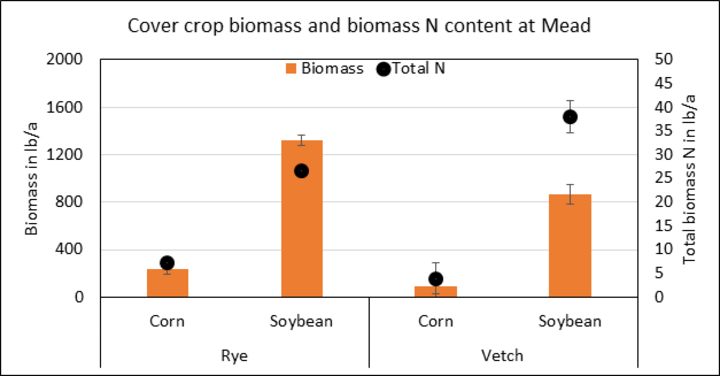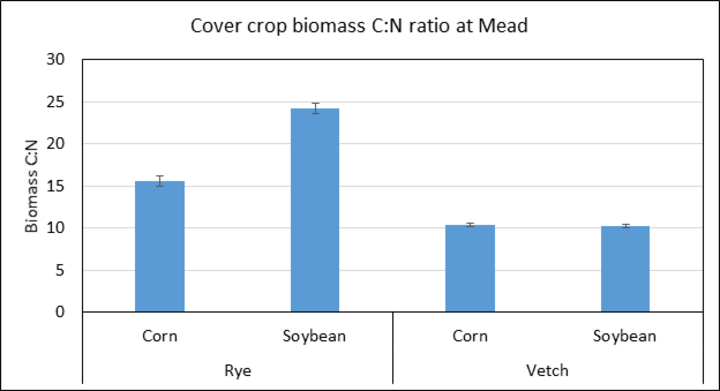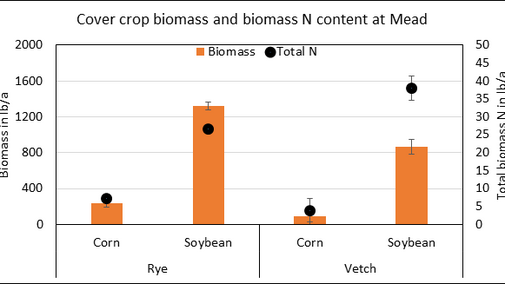Across Nebraska, the use of cover crops is increasing. Most commonly, winter cover crops are planted during the fallow period between corn or soybean harvest and the next crop. However, other windows for cover cropping exist in Nebraska. We are summarizing results from four years of cover crop trials that explored whether cover crops can improve soil health, increase soil nitrogen (N) retention and recycling, fix N for a subsequent crop, and provide food sources and habitat to pollinating insects.

Figure 1. Cereal rye and hairy vetch aboveground biomass (orange bars, values on left axis) and total N in lb/ac in its biomass (black dots, values on the right axis). Rye and vetch were interseeded into corn and soybean in mid-September 2017 at Mead. Biomass (as dry matter) and biomass N were sampled in early May 2018.

Do cover crops improve soil health?
We measured the size and stability of soil aggregates, coarse and fine particulate organic matter and soil microbial populations after four years of cover cropping with cereal rye and mixes of broadleaves with rye. We found increased macro-aggregation and increased particulate organic matter which improves healthy soil functions and soil resilience to erosion. Soil microbial populations were larger under rye cover crops and had more arbuscular mycorrhizal fungi and saprophytic fungi.
Do cover crops retain soil N and prevent nitrate losses?
Soil samples were taken from the 0-8 inch depth each spring at cover crop termination (two weeks before corn or soybean planting). Under rye cover crops, soil nitrate levels were lower than under the control in most site years. Rye can take up considerable amounts of N, depending on its physiological stage and biomass production. For example at Mead in 2018, rye planted into soybean contained 27 lb N/ac in its biomass (Figure 1). Thus, rye cover crops have the potential to lower soil N losses in the spring. In 2019, soil water under the cover crop root zone will be analyzed for nitrate to determine actual leaching losses.
Can cover crops be used as a source of N for the subsequent crop?
We planted hairy vetch cover crops to determine their suitability as an N source for the next crop. Vetch biomass production was low due to the limited growing period, ranging from 100 to 800 lb/a depending on site and year, and was generally higher planted into soybean than corn. At Mead in 2018 vetch planted into soybean contained 38 lb N/a (Figure 1) but when planted into corn, contained only 4 lb N/a because it grew very little. We did not measure how much of the N in vetch biomass was from biological fixation. Vetch biomass will likely decompose quickly as its C:N ratio was low (10:1) so N contained in vetch biomass should be available to the next crop quickly (Figure 2). Rye biomass has a higher C:N ratio (Figure 2) and will release its N slower. It should be noted that since rye biomass C:N is below 25:1 we do not expect N immobilization from a decaying rye cover crop.
Do cover crops improve pollinator habitat?
Habitat and food sources for pollinating insects are declining across the Midwest. In 2017 and 2018, we participated in a project evaluating how different landscape elements (windbreaks, native habitats, and cover crops) impact pollinator numbers. We planted a forage legume cover crop (red clover, white clover, and alfalfa) after winter wheat at Mead. Preliminary results show increases in the number of butterflies and moths where cover crops were planted. Monarch butterflies were one of the species observed feeding on clover flowers.

